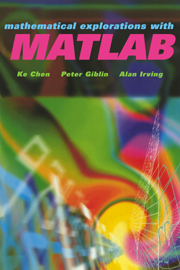Book contents
- Frontmatter
- Contents
- Preface
- Part one Foundations
- Part two Investigations
- 8 Magic Squares
- 9 GCDs, Pseudoprimes and Miller's Test
- 10 Graphics: Curves and Envelopes
- 11 Zigzags and Fast Curves
- 12 Sequences of Real Numbers
- 13 Newton–Raphson Iteration and Fractals
- 14 Permutations
- 15 Iterations for Nonlinear Equations
- 16 Matrices and Solution of Linear Systems
- 17 Function Interpolations and Approximation
- 18 Ordinary Differential Equations
- Part three Modelling
- Appendix 1 MATLAB Command Summary
- Appendix 2 Symbolic Calculations within MATLAB
- Appendix 3 List of All M-files Supplied
- Appendix 4 How to Get Solution M-files
- Appendix 5 Selected MATLAB Resources on the Internet
- References
- Index
15 - Iterations for Nonlinear Equations
Published online by Cambridge University Press: 08 February 2010
- Frontmatter
- Contents
- Preface
- Part one Foundations
- Part two Investigations
- 8 Magic Squares
- 9 GCDs, Pseudoprimes and Miller's Test
- 10 Graphics: Curves and Envelopes
- 11 Zigzags and Fast Curves
- 12 Sequences of Real Numbers
- 13 Newton–Raphson Iteration and Fractals
- 14 Permutations
- 15 Iterations for Nonlinear Equations
- 16 Matrices and Solution of Linear Systems
- 17 Function Interpolations and Approximation
- 18 Ordinary Differential Equations
- Part three Modelling
- Appendix 1 MATLAB Command Summary
- Appendix 2 Symbolic Calculations within MATLAB
- Appendix 3 List of All M-files Supplied
- Appendix 4 How to Get Solution M-files
- Appendix 5 Selected MATLAB Resources on the Internet
- References
- Index
Summary
One can find a lot of mathematical examples involving iterations and the solution of nonlinear equations. Such equations arise from solving nonlinear problems – either differential or statistical. Real world problems are often nonlinear and may involve more than one independent variable, although techniques may resemble or reduce to the one dimensional case. The main reason for iterations is that direct (i.e. analytical) solutions of nonlinear equations are in general difficult to find, and numerical solutions need more than one step to converge. This chapter mainly considers equations with real coefficients; see Chapter 13 for the complex case.
Aims of the project
The purpose of this investigation is to study if, when and how numerical methods work in the context of solving nonlinear equations. In particular, the important issues of accuracy and convergence speed of iterative methods are considered.
Mathematical ideas used
This project involves vectors and matrices. The method is based on iterations and linearisations of nonlinear equations. We first consider one equation in one unknown (prefixed by ID for simplicity), and then consider systems of equations in multiple unknowns (prefixed by 2D).
- Type
- Chapter
- Information
- Mathematical Explorations with MATLAB , pp. 189 - 206Publisher: Cambridge University PressPrint publication year: 1999

